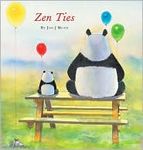" I discovered that one could write one's own story,
which is something that very few people even consider."
In 1998 I built the first rendition of Through the Looking Glass Book Reviews, and I did it myself, so you can imagine what it looked like! Back then I had no idea what TTLG would become in the years ahead. By 1999 I had got to know quite a few publicists in the publishing houses, and was getting review copies on a regular basis. One of the books I received was The Library, which was created by a husband and wife team. I fell in love with David Small's art and I sought out every book he had worked on.
This Caldecott Honor book had a profound effect on me; I discovered that I was not the only book-mad person in the world. Here was a story about a real person who filled her house with books. I was not alone in my madness! I also saw how someone turned their passion into something that gave them, and so many other people, joy. I discovered that one could write one's own story, which is something that very few people even consider. If the lady in the story could do what she did with her life, why, I could do something that was untraditional too.
The story is written in verse, so it is perfect title for Poetry Month.
The Library
Sarah Stewart
Illustrated David Small
Picture Book
For ages 5 to 8
Farrar, Straus and Giroux, 1999, 978-0374443948
From the time when she was a very little girl indeed Elizabeth Brown loved books. She had no interest in dolls or in playing games. All she wanted to do was to read, and read, and read. This state of affairs did not change as she grew up. As more and more books came into her home, her collection of books got bigger and bigger and bigger until it was so enormous that the front door of her house was blocked by piles of books. Even worse was the fact that Elizabeth no longer had room for "one more" book.
Then Elizabeth Brown found a solution to her problem, a solution that would make it possible for her to go on buying books, a solution that would also benefit the entire community.
This wonderful story with its spare rhyming text and its emotive watercolor washed paintings, is a joy to read. The dedication in the front of the book tells us that the Elizabeth Brown in the story was in fact a real person who loved books and who was a good friend of the author and illustrator.

























